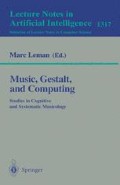Abstract
In this paper the concept of meter is investigated, taking into account elements of perception and performance. Considerable problems with the traditional theories lead to a broadened definition of meter as the temporal framework of music. A descriptive method for meter based on this definition is proposed, it consists of three main levels: essential beat patterns, metric hierarchies (meter in strict sense) and metric microstructure. The emphasis is on the importance of periodic beats and microstructure and of their combination to reach a complete description of meter. Finally the significance of interpretational elements in the perception of meter is discussed, stressing the need to start from performed music in order to obtain a correct image of the meter in a particular piece.
Preview
Unable to display preview. Download preview PDF.
References
Arom, S. (1984). Structuration du temps dans les musiques d'Afrique centrale: Périodicité, metre, rythmique et polyrythmie. Revue de Musicologie, 70, 5–36.
Arom, S. (1985). Polyphonies et polyrythmies intrumentales d'afrigue centrale (structure et méthodologie). Paris: Société d'études linguistiques et anthropologiques de France.
Bengtsson, I. (1987). Notation, motion and perception: Some aspects of musical rhythm. In A. Gabrielsson (Ed.), Action and perception in rhythm and music. Stockholm: Royal Swedish Academy of Music.
Benjamin, W. (1984). A theory of musical meter. Music Perception, 1, 355–413.
Blom, J., & Kvifte, T. (1986). On the problem of inferential ambivalence in musical meter. Ethnomusicology, 30, 491–517.
Clarke, E. (1985). Structure and expression in rhythmic performance. In P. Howell, I. Cross, & R. West (Eds.), Musical structure and cognition. London: Academic Press.
Clynes, M. (1987). What can a musician learn about music performance from newly discovered microstructure principles (PM and PAS)? In A. Gabrielsson (Ed.), Action and perception in rhythm and music (Vol. 39). Stockholm: Royal Swedish Academy of Music.
Clynes, M., & Walker, J. (1982). Neurobiologic functions of rhythm, time, and pulse in music. In M. Clynes (Ed.), Music, mind and brain: The neuropsychology of music. New York, NY: Plenum Press.
Cooper, G., & Meyer, L. (1960). The rhythmic structure of music. Chicago, IL: University of Chicago Press.
Desain, P., & Honing, H. (1995). Computationeel modelleren van beatinductie. In Van frictie tot wetenschap-jaarboek 1994–1995. Amsterdam: Vereniging van Academie-onderzoekers.
Fraisse, P. (1982). Rhythm and tempo. In D. Deutsch (Ed.), The psycology of music. New York, NY: Academic Press.
Handel, S. (1989). Listening. An introduction to the perception of auditory events. Cambridge, MA: The MIT Press.
Houle, G. (1987). Meter in music, 1600–1800 — performance, perception, and notation. Bloomington, Indianapolis: Indiana University Press.
Jones, M. (1987). Perspectives on musical time. In A. Gabrielsson (Ed.), Action and perception in rhythm and music (Vol. 39). Stockholm: Royal Swedish Academy of Music.
Koffka, K. (1963). Principles of Gestalt psychology. New York, NY: Harcourt, Brace, and World.
Kolinski, M. (1973). A cross-cultural approach to metro-rhythmic patterns. Ethnomusicology, XVII, 494–506.
Kramer, J. (1988). The time of music. New York, NY: Schirmer Books.
Lee, C. (1991). The perception of metrical structure: Experimental evidence and a model. In P. Howell, I. Cross, & R. West (Eds.), Representing musical structure. London: Academic Press.
Leman, M. (1993). Symbolic and subsymbolic description of music. In G. Haus (Ed.), Music processing. Madison, WI: A-R Editions.
Leman, M. (1995). Music and schema theory: Cognitive foundations of systematic musicology. Berlin, Heidelberg: Springer-Verlag.
Lerdahl, F., & Jackendoff, R. (1983). A generative theory of tonal music. Cambridge, MA: The MIT Press.
London, J. (1995). Some examples of complex meters and their implications for models of metric perception. Music Perception, 13, 59–77.
Longuet-Higgins, H., & Lee, C. (1984). The rhythmic interpretation of monophonic music. Music Perception, 1, 424–441.
Palmer, C., & Krumhansl, C. (1990). Mental representations for musical meter. Journal of Experimental Psychology: Human Perception and Performance, 16, 728–741.
Parncutt, R. (1993). Template-matching models of musical pitch and rhythm percpetion. In J. Louhivuori & J. Laaksamo (Eds.), Proceedings of the First International Conference on Cognitive Musicology (pp. 1–19). University of Jyväskylä.
Parncutt, R. (1994). A perceptual model of pulse salience and metrical accent in musical rhythms. Music Perception, 11, 409–464.
Parncutt, R. (in press). Expressive communication of musical structure in piano performance. In W. Auhagen, B. Gätjen, & K. Niemöller (Eds.), Systemische Musikwissenschaft — Festschrift Jobst Peter Fricke zum 65. Geburtstag. Cologne: Musikwissenschaftliches Institut der Universität zu Köln.
Povel, D. (1984). A theoretical framework for rhythm perception. Psychological Research, 45, 315–337.
Repp, B. (1989). Expressive microstructure in music: A preliminary perceptual assessment of four composers' “pulses”. Music Perception, 6, 243–274.
Repp, B. (1990). Composers' pulses: Science or art? Music Perception, 7, 423–434.
Sabbe, H. (1994). Algemene muziekleer voor de 20ste eeuw. Ghent: Academia Press.
Sachs, C. (1953). Rhythm and tempo: A study in music history. New York, NY: W.W. Norton.
Seifert, U., Olk, F., & Schneider, A. (1995). On rhythm perception: Theoretical issues, empirical findings. Journal of New Music Research, 24, 164–195.
Sloboda, J. (1985). The musical mind: The cognitive psychology of music. Oxford: Clarendon Press.
Sundberg, J., Friberg, A., & Frydén, L. (1991). Common secrets of musicians and listeners: An analysis-by-synthesis study of musical performance. In P. Howell, I. Cross, & R. West (Eds.), Musical structure and cognition (pp. 161–197). London: Academic Press.
Thompson, W. (1989). Composer-specific aspects of musical performance: An evaluation of Clynes's theory of pulse for performances of Mozart and Beethoven. Music Perception, 7, 15–42.
Todd, N. (1985). A model of expressive timing in tonal music. Music Perception, 3, 33–58.
Vos, P. (1973). Waarneming van metrische toonreeksen. Nijmegen: Stichting Studentenpers.
Zuckerkandl, V. (1959). The sense of music. Princeton N.J.: Princeton University Press.
Author information
Authors and Affiliations
Editor information
Rights and permissions
Copyright information
© 1997 Springer-Verlag Berlin Heidelberg
About this paper
Cite this paper
Moelants, D. (1997). A framework for the subsymbolic description of meter. In: Leman, M. (eds) Music, Gestalt, and Computing. JIC 1996. Lecture Notes in Computer Science, vol 1317. Springer, Berlin, Heidelberg. https://doi.org/10.1007/BFb0034120
Download citation
DOI: https://doi.org/10.1007/BFb0034120
Published:
Publisher Name: Springer, Berlin, Heidelberg
Print ISBN: 978-3-540-63526-0
Online ISBN: 978-3-540-69591-2
eBook Packages: Springer Book Archive

